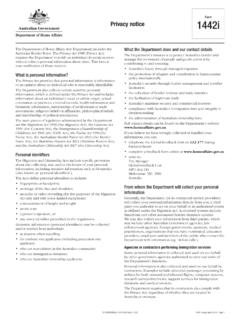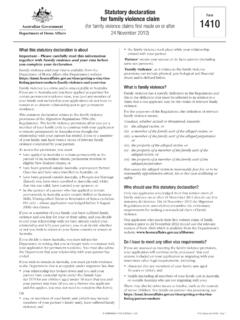Transcription of Chapter 2 SPCC Rule Applicability - US EPA
1 SPCC GUIDANCE FOR REGIONAL INSPECTORS 2-1 December 16, 2013 Chapter 2 SPCC Rule Applicability Introduction The SPCC rule establishes requirements to prepare and implement SPCC Plans. SPCC Plans complement existing laws, regulations, rules , standards, policies, and procedures pertaining to safety, fire prevention, and oil pollution prevention. The purpose of an SPCC Plan is to form a comprehensive oil spill prevention program that minimizes the potential for discharges. The SPCC Plan must address all relevant spill prevention, control, and countermeasures necessary at the specific facility. The rule applies to the owners and operators of non-transportation-related onshore and offshore facilities that could reasonably be expected to discharge oil into navigable waters of the United States or adjoining shorelines in quantities that may be harmful. This Chapter clarifies which facilities, activities, and equipment are subject to the SPCC rule. The facility owner/operator is responsible for determining whether the facility is subject to the SPCC rule, however, this determination is subject to review by the Regional Administrator or his delegated representative.
2 Summary of General Applicability Section establishes the general Applicability of the SPCC rule. The SPCC rule applies to facilities that: Are non-transportation-related; Have an aboveground oil storage capacity of more than 1,320 gallons or a completely buried oil storage capacity greater than 42,000 ; and Could reasonably be expected to discharge oil to navigable waters or adjoining shorelines in quantities that may be harmful. Facilities that are owned and operated by federal, state, local government or tribal entities are equally subject to the regulationP20P as any other facility (although the federal government is not subject to civil penalties). Unlike some other federal environmental programs, the Clean Water Act does not authorize EPA to delegate the SPCC program implementation or enforcement to State, local, or tribal representatives. 20 The SPCC rule requires an owner or operator to develop an SPCC Plan.
3 Under the CWA the definition of owner or operator includes person which includes federal, state and local government or tribal entities (33 USC 1362(4) (CWA Section 502(4))). (b) ..this part applies to any owner or operator of a non-transportation-related onshore or offshore facility engaged in drilling, producing, gathering, storing, processing, refining, transferring, distributing, using, or consuming oil and oil products, which due to its location, could reasonably be expected to discharge oil in quantities that may be harmful, as described in part 110 of this Chapter , into or upon the navigable waters of the United States or adjoining Note: The above text is an excerpt of the SPCC rule. Refer to 40 CFR part 112 for the full text of the rule. SPCC GUIDANCE FOR REGIONAL INSPECTORS 2-2 December 16, 2013 Chapter 2: Applicability Section (d) describes facilities subject to EPA jurisdiction ( , that are non-transportation-related) and the activities and equipment that are exempt from the SPCC rule and from the facility total oil storage capacity calculations.
4 The section also describes the types of facilities that are outside EPA jurisdiction and therefore not subject to the SPCC rule. Notwithstanding the exemptions provided in (d), under (f) the Regional Administrator has discretion to require the owner or operator of any facility, subject to EPA s jurisdiction under 311(j) of the Clean Water Act (CWA), to prepare and implement an SPCC Plan, or part of an SPCC Plan. This Chapter further explains each of the Applicability criteria listed in and provides examples of how these criteria are applied. The remainder of this Chapter is organized as follows: Section discusses the definition of oil and the regulated activities. Section discusses activities involving oil. Section explains what a facility is and provides examples of how a facility can be determined. Applicability Specifically, EPA exempts: - Any facility where the completely buried oil storage capacity is 42,000 gallons or less and the aggregate aboveground oil storage capacity is 1,320 gallons or less; - Completely buried oil tanks and associated piping and equipment that are subject to all of the technical requirements under 40 CFR part 280 or 281; - Underground oil storage tanks, including below-grade vaulted tanks that supply emergency diesel generators at a nuclear power generation facility licensed by the Nuclear Regulatory Commission (NRC) and subject to any NRC provision regarding design and quality criteria, including but not limited to 10 CFR part 50; - Permanently closed oil containers; - Any container with an oil storage capacity less than 55 gallons; - Any facility or part thereof used exclusively for wastewater treatment; - Motive power oil containers; - Hot-mix asphalt or any hot-mix asphalt container.
5 - Containers storing heating oil used solely at a single-family residence; - Pesticide application equipment or related mix containers (with adjuvant oil); - Intra-facility oil gathering lines subject to the regulatory requirements of 49 CFR part 192 or 195; and - Any milk and milk product container and associated piping and appurtenance. Do not include exempt oil containers or oil equipment when calculating the total oil storage capacity of the facility. (see (d)) SPCC GUIDANCE FOR REGIONAL INSPECTORS 2-3 December 16, 2013 Chapter 2: Applicability Section discusses the difference between transportation-related and non-transportation-related facilities in determining jurisdiction of regulatory agencies. Section discusses the criteria for a facility to have a reasonable expectation of a discharge to navigable waters in quantities that may be harmful. Section addresses storage capacity thresholds and methods of calculating storage capacity.
6 Section addresses the exemptions to the SPCC rule. Section discusses the process for a Regional Administrator to determine Applicability , outside of the exemptions listed in (d). Section addresses the Applicability of the rule requirements to different kinds of containers. Section discusses the Applicability of Facility Response Plan (FRP) requirements. Section describes the role of the EPA inspector. Definition of Oil The SPCC rule applies to the owners and operators of facilities with the potential to discharge oil in quantities that may be harmful to navigable waters or adjoining shorelines. The SPCC rule s definition of oil derives from 311(a)(1) of the Clean Water Act (CWA) which defines oil as oil of any kind or in any form, including, but not limited to, petroleum, fuel oil, sludge, oil refuse, and oil mixed with wastes other than dredged spoil. OPA 1001 defined oil separately to exclude any substance which is specifically listed or designated as a hazardous substance under Comprehensive Environmental Response, Compensation, and Liability Act (CERCLA) and which is subject to provisions of that 21P Although oil is defined separately under OPA, that definition did not amend the original CWA definition of oil in 311(a)(1) and therefore was not incorporated into the definition of oil under 40 CFR part that applies to both SPCC and FRP regulatory requirements.
7 21 Under OPA, oil means oil of any kind or in any form, including petroleum, fuel oil, sludge, oil refuse, and oil mixed with wastes other than dredged spoil, but does not include any substance which is specifically listed or designated as a hazardous substance under subparagraphs (A) through (F) of section 101(14) of the Comprehensive Environmental Response, Compensation, and Liability Act (42 9601) and which is subject to the provisions of that Act. Oil means oil of any kind or in any form, including, but not limited to: fats, oils, or greases of animal, fish, or marine mammal origin; vegetable oils, including oils from seeds, nuts, fruits, or kernels; and, other oils and greases, including petroleum, fuel oil, sludge, synthetic oils, mineral oils, oil refuse, or oil mixed with wastes other than dredged spoil. Note: The above text is an excerpt of the SPCC rule. Refer to 40 CFR part 112 for the full text of the rule.
8 SPCC GUIDANCE FOR REGIONAL INSPECTORS 2-4 December 16, 2013 Chapter 2: Applicability In response to Edible Oil Regulatory Reform Act (EORRA) of 1995 (33 2720) requirements, the oil definition under was revised to include the categories of oil in EORRA. Those categories are: (1) petroleum oils, (2) animal fats and vegetable oils; and, (3) other non-petroleum oils and Section of the SPCC rule defines oil as oil of any kind or in any form, including, but not limited to: fats, oils, or greases of animal, fish, or marine mammal origin; vegetable oils, including oils from seeds, nuts, fruits, or kernels; and, other oils and greases, including petroleum, fuel oil, sludge, synthetic oils, mineral oils, oil refuse, or oil mixed with wastes other than dredged spoil. The Coast Guard (USCG) maintains a separate list of substances it considers oil for its regulatory purposes. The list is available on the USCG Web site and may be used as a guide when determining if a particular substance is an However, it is important to note that for purposes of EPA s regulations, the USCG list is not comprehensive and does not include all oils that are subject to 40 CFR part 112.
9 The sections below discuss whether or not specific substances are considered oils for purposes of SPCC regulation. Petroleum Oils and Non-Petroleum Oils The SPCC rule applies to both petroleum oils and non-petroleum oils. Petroleum oils include, but are not limited to, crude and refined petroleum products, asphalt, gasoline, fuel oils, mineral oils, naphtha, sludge, oil refuse, and oil mixed with wastes other than dredged spoil. Nonpetroleum oils and greases include coal tar, creosote, silicon fluids, pine oil, turpentine, and tall oils. (67 FR 47075, July 17, 2002). Subpart B of 40 CFR part 112 covers both petroleum oils and non-petroleum Petroleum oils and non-petroleum oils, including synthetic oils, share common physical properties and produce similar environmental effects. Petroleum and non-petroleum oils can enter all parts of an aquatic system and adjacent shoreline, and similar methods of containment, removal and cleanup are used to reduce the harm created by spills of both types of oils.
10 Synthetic Oils Synthetic oils are used in a wide range of applications, including as heat transfer fluids, engine fluids, hydraulic and transmission fluids, metalworking fluids, dielectric fluids, compressor lubricants, and turbine lubricants. Synthetic oils are created by chemical synthesis rather than by refining petroleum crude or extracting oil from plant seeds. Oils that are derived from plant material may be considered animal fats and vegetable oils under subpart C of 40 CFR part 112. 22 EPA provided notice in 1975 that affirmed that animal fats and vegetable oils (AFVOs) were subject to the SPCC rule (40 FR 28849, July 9, 1975). For more information see Chapter 1: Introduction. 23 See the List of Petroleum and Non-Petroleum Oils on the USCG Web site at under Additional References. SPCC GUIDANCE FOR REGIONAL INSPECTORS 2-5 December 16, 2013 Chapter 2: Applicability Animal Fats and Vegetable Oils (AFVO) Animal fats and vegetable oils are covered under the SPCC regulation.


















